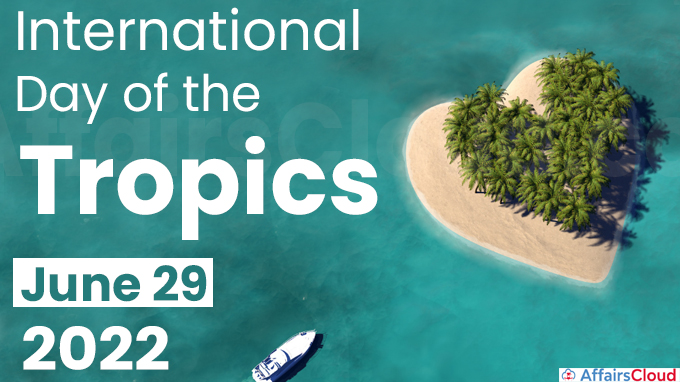
The United Nations(UN)’s International Day of the Tropics is annually observed across the globe on 29th June to create awareness about the specific challenges faced by tropical areas and to highlight the important role of the tropical countries in achieving Sustainable Development Goals(SDGs).
- The day also celebrates the diversity of the tropics and highlights the unique challenges and opportunities of the tropics.
Background:
The United Nations General Assembly(UNGA) adopted the resolution A/RES/70/267 on 14th June 2016 and proclaimed the 29th June of every year as the International Day of the Tropics.
Why June 29?
The 29th June was chosen to honour the anniversary of the launch of the 1st edition of “State of the Tropics Report” on 29th June 2014.
- The inaugural State of the Tropics Report was launched By Nobel Peace prize winner Aung San Suu Kyi of Myanmar.
Events:
James Cook University (JCU), Australia has organised a special event as part of the observance of International Day of the Tropics and to launch the 2022 State of the Tropics(SOTT) report: “COVID-19 in the Tropics: A State of the Tropics focus report”
Tropics:
i.The region of Tropics is defined as the area between the tropic of Cancer and the tropic of Capricorn.
ii.The tropical regions are typically warm, although topography and other factors contribute to climatic variation.
iii.Challenges faced by Tropical regions include climate change, deforestation, logging, urbanisation and demographic changes.
Human system of Tropics:
i.According to the UN, by 2050, the tropical region will host most of the world’s population and two-thirds of the World’s children.
ii.Compared to the rest of the world, the people of the tropics experience undernourishment, due to higher levels of poverty.
iii.Compared to the rest of the world, the proportion of the urban population living in slum conditions is higher in the Tropics.
Additional info:
i.According to State of The Tropics 2021, the Tropical region houses around 95% of the world’s mangrove forests by area and 99% of mangrove species.
ii.The region has around 54%, more than half of the world’s renewable water resources, yet almost half of the Topical population is considered vulnerable to water stress.
iii.Despite its greater biodiversity, the loss of biodiversity is also greater in the Tropics compared to the rest of the world.




